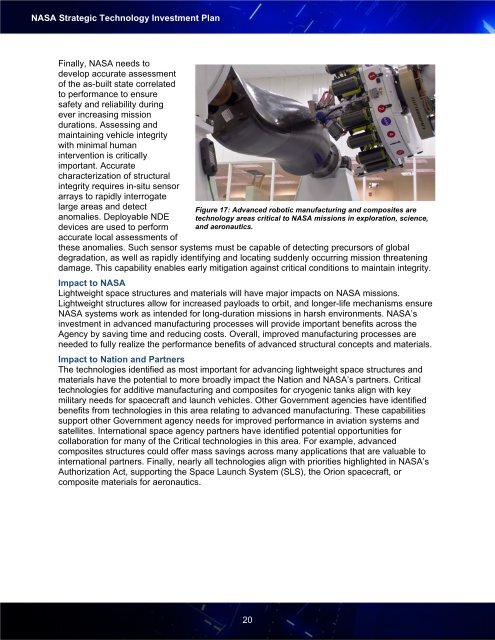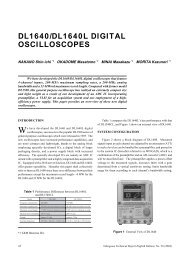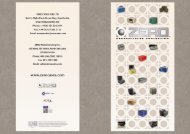2017-8-1_stip_final-508ed
You also want an ePaper? Increase the reach of your titles
YUMPU automatically turns print PDFs into web optimized ePapers that Google loves.
NASA Strategic Technology Investment Plan<br />
Finally, NASA needs to<br />
develop accurate assessment<br />
of the as-built state correlated<br />
to performance to ensure<br />
safety and reliability during<br />
ever increasing mission<br />
durations. Assessing and<br />
maintaining vehicle integrity<br />
with minimal human<br />
intervention is critically<br />
important. Accurate<br />
characterization of structural<br />
integrity requires in-situ sensor<br />
arrays to rapidly interrogate<br />
large areas and detect<br />
anomalies. Deployable NDE<br />
devices are used to perform<br />
accurate local assessments of<br />
Figure 17: Advanced robotic manufacturing and composites are<br />
technology areas critical to NASA missions in exploration, science,<br />
and aeronautics.<br />
these anomalies. Such sensor systems must be capable of detecting precursors of global<br />
degradation, as well as rapidly identifying and locating suddenly occurring mission threatening<br />
damage. This capability enables early mitigation against critical conditions to maintain integrity.<br />
Impact to NASA<br />
Lightweight space structures and materials will have major impacts on NASA missions.<br />
Lightweight structures allow for increased payloads to orbit, and longer-life mechanisms ensure<br />
NASA systems work as intended for long-duration missions in harsh environments. NASA’s<br />
investment in advanced manufacturing processes will provide important benefits across the<br />
Agency by saving time and reducing costs. Overall, improved manufacturing processes are<br />
needed to fully realize the performance benefits of advanced structural concepts and materials.<br />
Impact to Nation and Partners<br />
The technologies identified as most important for advancing lightweight space structures and<br />
materials have the potential to more broadly impact the Nation and NASA’s partners. Critical<br />
technologies for additive manufacturing and composites for cryogenic tanks align with key<br />
military needs for spacecraft and launch vehicles. Other Government agencies have identified<br />
benefits from technologies in this area relating to advanced manufacturing. These capabilities<br />
support other Government agency needs for improved performance in aviation systems and<br />
satellites. International space agency partners have identified potential opportunities for<br />
collaboration for many of the Critical technologies in this area. For example, advanced<br />
composites structures could offer mass savings across many applications that are valuable to<br />
international partners. Finally, nearly all technologies align with priorities highlighted in NASA’s<br />
Authorization Act, supporting the Space Launch System (SLS), the Orion spacecraft, or<br />
composite materials for aeronautics.<br />
20







